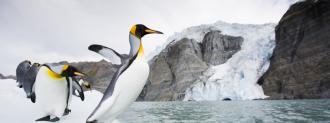South Georgia Island is one of the most biodiverse places on Earth, with more marine species than even the Galapagos — and it’s currently in the path of a massive iceberg.
If the iceberg hits the island, the collision could have a huge impact on the penguins, seals, and other wildlife that live on or around it.
In January, U.K. scientists will embark on a mission to South Georgia Island to assess the situation — bringing a pair of autonomous drone submarines along with them.
Iceberg, Dead Ahead
The iceberg, known as A-68a, broke off from Antarctica in 2017, and since then, it has been heading north in the Atlantic Ocean.
At one point, A-68a was the largest iceberg in the world. It has shrunk a bit in recent months, but it’s by no means small — with an area of 1,500 square miles, the iceberg is now almost exactly the same size as the island it’s heading straight toward.
As of December 15, the iceberg was less than 50 miles away from South Georgia Island, and scientists expect one of two things to happen next.
One possibility is that the ocean currents around the island carry the iceberg back out to sea. The other is that the iceberg grounds itself on the shallow seabed around South Georgia Island, where it could remain for up to 10 years.
That grounding could block penguins and seals’ access to food, leading to mass starvations on the island.
“(The animals) are fixed to their base, and without being able to get out, feed, and get back quickly, they have got a real problem,” Geraint Tarling, an ecologist with the British Antarctic Survey (BAS), told the Guardian.
The whole ecosystem might stop thriving.
Geraint Tarling
That’s not the only potential problem, either.
The water around South Georgia Island is relatively warm saltwater. However, the iceberg is made of freezing cold freshwater, meaning its grounding will instantly change the local environment.
“(Native plants) might not be able to grow as well, and that means there’s not as much food available for zooplankton and krill, which are then the food for the penguins and seals,” Tarling explained. “And so, the whole (ecosystem) might stop thriving.”
Studying South Georgia Island
In January, Tarling and other BAS scientists will lead a team of researchers on a mission to assess the impact of A-68a on South Georgia Island. As part of that project, the group plans to deploy a pair of low-power, autonomous underwater robots known as gliders.
The gliders don’t use energy-intensive propellers to move through the water. Instead, they change their buoyancy and then use special wings to convert that movement into forward motion.
Once deployed, the gliders will spend about four months collecting information on the water’s temperature, salinity, and other factors. Periodically, they’ll surface to send their data to the researchers and obtain any new targets.
“Autonomous submarine gliders are an excellent, cost-effective, and sustainable means of gathering and recording important marine data,” Steve Woodward, the researcher who will manage the glider operation, said in a press release.
“In this case, we will program the…gliders to get as close to the edge of the iceberg as we feel is safe and practicable, and collect the data that will be needed to enable the team to understand the implications of what is taking place with A-68a,” he continued.
We’d love to hear from you! If you have a comment about this article or if you have a tip for a future Freethink story, please email us at [email protected].






